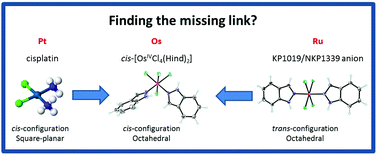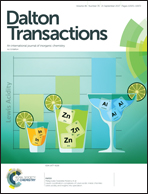cis-Tetrachlorido-bis(indazole)osmium(iv) and its osmium(iii) analogues: paving the way towards the cis-isomer of the ruthenium anticancer drugs KP1019 and/or NKP1339†‡
Abstract
The relationship between cis–trans isomerism and anticancer activity has been mainly addressed for square-planar metal complexes, in particular, for platinum(II), e.g., cis- and trans-[PtCl2(NH3)2], and a number of related compounds, of which, however, only cis-counterparts are in clinical use today. For octahedral metal complexes, this effect of geometrical isomerism on anticancer activity has not been investigated systematically, mainly because the relevant isomers are still unavailable. An example of such an octahedral complex is trans-[RuCl4(Hind)2]−, which is in clinical trials now as its indazolium (KP1019) or sodium salt (NKP1339), but the corresponding cis-isomers remain inaccessible. We report the synthesis of Na[cis-OsIIICl4(κN2-1H-ind)2]·(Na[1]) suggesting a route to the cis-isomer of NKP1339. The procedure involves heating (H2ind)[OsIVCl5(κN1-2H-ind)] in a high boiling point organic solvent resulting in an Anderson rearrangement with the formation of cis-[OsIVCl4(κN2-1H-ind)2] ([1]) in high yield. The transformation is accompanied by an indazole coordination mode switch from κN1 to κN2 and stabilization of the 1H-indazole tautomer. Fully reversible spectroelectrochemical reduction of [1] in acetonitrile at 0.46 V vs. NHE is accompanied by a change in electronic absorption bands indicating the formation of cis-[OsIIICl4(κN2-1H-ind)2]− ([1]−). Chemical reduction of [1] in methanol with NaBH4 followed by addition of nBu4NCl afforded the osmium(III) complex nBu4N[cis-OsIIICl4(κN2-1H-ind)2] (nBu4N[1]). A metathesis reaction of nBu4N[1] with an ion exchange resin led to the isolation of the water-soluble salt Na[1]. The X-ray diffraction crystal structure of [1]·Me2CO was determined and compared with that of trans-[OsIVCl4(κN2-1H-ind)2]·2Me2SO (2·2Me2SO), also prepared in this work. EPR spectroscopy was performed on the OsIII complexes and the results were analyzed by ligand-field and quantum chemical theories. We furthermore assayed effects of [1] and Na[1] on cell viability and proliferation in comparison with trans-[OsIVCl4(κN1-2H-ind)2] [3] and cisplatin and found a strong reduction of cell viability at concentrations between 30 and 300 μM in different cancer cell lines (HT29, H446, 4T1 and HEK293). HT-29 cells are less sensitive to cisplatin than 4T1 cells, but more sensitive to [1] and Na[1], as shown by decreased proliferation and viability as well as an increased late apoptotic/necrotic cell population.



 Please wait while we load your content...
Please wait while we load your content...